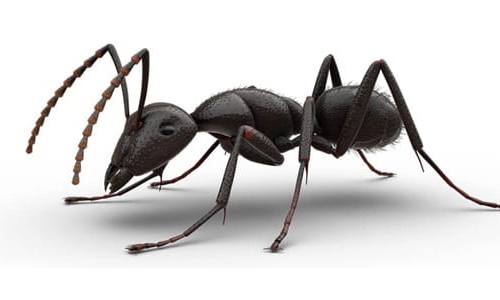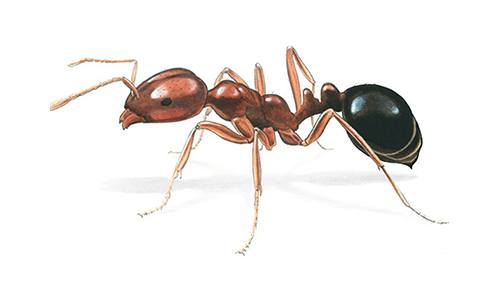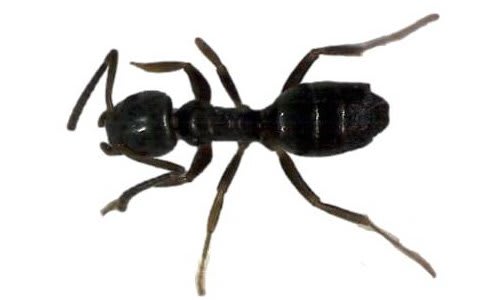
Crazy Ants
Learn how to get rid of Crazy ants and what are Crazy ants.
You can identify a Crazy Ant by its erratic and "crazy" movement when disturbed. These ants seem to run aimlessly around. Another distinguishing feature is that their legs and antennae are longer in proportion to their bodies, compared to other types of ants. Crazy Ants are invasive ants. In some cases, even Fire Ants are easier to treat since their mounds can be determined and treated. Crazy Ants do not burrow or form mounds. To make it even more difficult to control, the Black Crazy Ant or "Longhorn Crazy Ant" clone the queen and her mates, for faster reproduction. They have a bad reputation of damaging electrical and computer equipment. They have had negative impact on industrial sites and have caused problems around residential homes.
The Rasberry/Tawny crazy ant (discovered by Tom Rasberry in 2002), is related to the Caribbean crazy ant, a serious invasive pest in Florida. They can be easily transported; common in shipping containers and other commerce. They may be found indoors, where they can survive all year in the northern states. Tom Rasberry writes in his blog that the Rasberry Crazy Ant can reach billions per acre. He states that they eat other insects or compete for food, resulting in a disappearance of insect populations, having a negative impact on ecological systems. They also can be seen throughout the south, some Midwest states, as well California, Arizona and Hawaii.
- Tawny (Rasberry) Crazy Ant (Nylanderia fulva)
- Caribbean Crazy Ant (formerly called Nylanderia pubens)
- Black Crazy Ant (Longhorn Crazy Ant) (Paratrechina longicornis)
1. Inspect For Crazy Ants
Because the crazy ants wander in aimless movements instead of a straight trail, it may be difficult to locate a trail to treat.
Placing both a sweet and protein food sources (jelly or honey /tuna or peanut butter), may cause them to trail to the food. At that point, you can spray and or bait with the suggested products listed below on the trails. Look under rocks, stumps, landscape timbers, firewood, and any rotting wood. Crazy Ants forage over long distances, so it is important to search diligently.
2. Seal All Possible Entry Points
Seal all possible entry points around windows and doors if possible. Trim vegetation away from structures to limit the ant's pathway. Clean up any food and spills to avoid attracting the crazy ants.
3. Ant Baits
Invict Blitz and Invict Xpress with Imidacloprid are excellent baits for mega-colony and persistent ants like, Crazy Ants on the protein cycle. Use Advion Ant Bait Gel on their sugar cycles.
The workers take these baits back to the nest and feed the larvae. You can use it the Invict around the perimeter, on the lawn or inside your homes in cracks and crevices.
Since Crazy Ants need moisture, look for areas that are damp. Keep exposed bait away from pets and children.
Since Taurus SC, FUSE, and Dominion 2L are non-repellent products, they will not interfere with Invict Blitz or Invict Xpress. Wait until the Taurus SC, FUSE,or Dominion 2L dries, if applying the bait in the same general area.
Get Rid Of Crazy Ants
Mega Colony Kit (Contains both baits and non-repellent insecticide)
The Mega-Colony Ant Kit has Advion Ant Bait, Invict Xpress and Dominion 2L combined as a kit, saving money. Use the baits on the inside and outside where you see the ants foraging and use the Dominon 2L as a spray on the ground and foliage.
4. Use Non-Repellent Insecticides
Spray a non-repellent insecticide such as Taurus SC (makes 12.5 gallons at strongest strength) or FUSE (makes 50 gallons at strongest strength) around the perimeter of your home and Dominion 2L (makes 55 gallons at strongest strength) on the ant trails and other possible crazy ant locations.
Spray Taurus SC one foot up and one foot out from the foundation of your home, twice a year. Fuse may be used in a narrow band of 1 ft up and 1 fto out 4 times a year or a wider band of 2ft up and 2 ft out, twice a year. Taurus and Fuse may not be used inside. The Taurus or FUSE treatments will also keep other ants away.
Spray Dominion 2L around the ground or soil adjacent to the building where the ants are foraging. Spray Dominion 2L to shrub, flower, or ornamental plant beds where the Crazy Ants may be foraging.
Taurus SC, FUSE, and Dominion 2L are non-repellent insecticides, the ants can not detect it to avoid it. As the Crazy Ant passes over the insecticide, it spreads it to other ants. They groom each other, and it gets into their guts. As they regurgitate to feed other ants, these insecticides are passed into their food sources.
Inside Spraying: Taurus SC, Fuse, and Dominion2L) can't be sprayed inside. If you want to add a non-repellent insecticide, use Advion WDG.
Rasberry/Tawny Crazy Ant
The legs of the Rasberry crazy ant are long in proportion to their body. They make erractic movements, apparently disorganized and "crazy". Rasberry/Tawny Crazy Ants have a protective shield to protect them from fire ants.
They have done a lot of damage to electrical outlets and short -circuiting electronics.
Rasberry Crazy Ant: 1/8 inch long, reddish brown
Distribution: They become very numerous in Texas and the Gulf states.
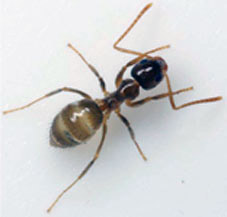

Black Crazy Ant
The Black Crazy Ant looks like it should be called "longhorned crazy ant"
Black Crazy Ant Coloring: Brown/Black with a bluish tint
Distribution: May be found sporadically over the entire US, but is very common in Florida and along the Gulf Coast, including TX, LA, MS, AL, GA, and SC.

Recommended Products
Identification
Caribbean Crazy Ant
Caribbean Crazy Ant: 1/8" long, covered in reddish-brown hairs
Color: Golden Brown-Reddish Brown
Distribution: Florida and Gulf States and Texas. Based on observations of heavily infested areas, colonies may contain hundreds of thousands of individuals among interconnected sites.
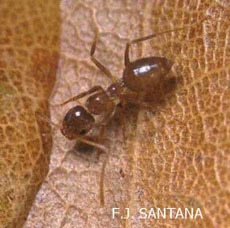
Mechanical Means: Seal all possible entry points around windows and doors if possible. Trim vegetation away from structures to limit the ant's pathway. Clean up any food and spills to avoid attracting the crazy ants.
Biology and Habits
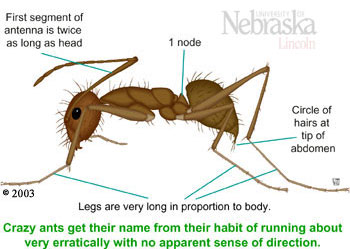
Nests: Crazy Ants (queens, eggs, larvae, and pupae) can be found under or in many objects. Each colony may contain millions of ants, as multiple queens lay hundreds of eggs. Inside, Crazy ants can nest in small cracks and crevices and voids, particularly moist areas. Once inside a building, they wander searching for food. Outside, they may be found in damp soil, under rocks, stumps, timbers, compost, garbage and potted plants. These ants can adapt to dry conditions. The crazy ants' nests may be far away in distance from their foraging areas.They can travel quite a distance to forage for food.
Diet: They prefer to eat protein, animal matter, grease and other insects, but they will readily eat sweets. You may find them foraging inside your kitchen. If eating sweets, they are attracted to honey from beehives, ripened fruits, honeydew (the excretions from aphids and other insects), and any sweet part of a plant. They will eat other insects, both living and dead. They are predators, foragers and scavengers. Crazy Ants may want only protein during the summer months, but that may vary from colony to colony.
Bites: These ants can bite, but do not sting. Due to their invasive nature, they can displace other ant species and affect honeybees and birds.
Prevent Crazy Ants

Seal all possible entry points around windows and doors if possible.
Caulk cracks around doors and windows.
Seal utility openings like wires and pipes.
Clean up any food and spills to avoid attracting the crazy ants.

Trim vegetation away from structures to limit the ant's pathway.
Written by our resident pest control expert Ken Martin.






